Thursday, June 12, 2008
10 Best and Worst School Districts in the US
Here is an article that was sent to me listing the top 10 best and worst school districts in the US based on graduation rates. Also listed are the top 10 fastest growing school districts in the country. As a teacher starting out I would consider this a valuable resource. Remember, just because graduate rates are down does not mean you schould write off a district. Often times these are the students who need extra care and help and if you are up to the job it can be extremely rewarding.
Labels:
job hunt,
job search,
school districts,
teacher,
teaching jobs,
urban school
Wednesday, June 11, 2008
Coloring Page Maker
Crayola.com has an online coloring page maker that is so easy to use, a 2nd grader could create his/her own coloring sheet after they finish their work! http://www.crayola.com/coloring-page-maker/
Labels:
art,
art class,
art club,
art education,
children,
crayola,
elementary school,
kids
Tuesday, June 10, 2008
Cross Curricular Approach
So ofcourse, if we are doing our jobs our students are learning social studies, math, science, and literacy along with art. If you really want to incorporate what the students are learning in the classroom with art check your state standards for math, science, language arts, reading, and social studies. Also you can ask classroom teachers what units they work on throughout the year so you can incoroporate that into your art curriculum.
Monday, June 9, 2008
Wishlist
To keep myself better organized with ordering I signed up to an online account at Dick Blick and when I think of a supply that my classroom needs I add it to my wishlist.
Labels:
art,
art class,
art supplies,
dick blick,
ordering supplies,
supplies,
teacher,
teaching
Friday, June 6, 2008
I Hate This Project!!!
Every so often I hear this from a student. Sometimes a group of students, sometimes a class! So what do I say to that? I generally try to listen to see why the student dislikes the project. Maybe they feel that their drawing skills aren't up to par, maybe they can't stop turning clay into mush with water, maybe they just have a short attention span. If the students struggle across the board, I try to adjust to meet their needs. If it is the same student who always complains, I take their criticism with a grain of salt.
Thursday, June 5, 2008
Permanent Marker Rules
When my students use permanent markers I give them the following rules:
1. Do not draw on eachother.
2. Do not draw on yourself.
3. Do not draw on another's paper or clothing.
4. Do not draw on the table.
5. All you draw on is your paper!!!
1. Do not draw on eachother.
2. Do not draw on yourself.
3. Do not draw on another's paper or clothing.
4. Do not draw on the table.
5. All you draw on is your paper!!!
Wednesday, June 4, 2008
Warhol Flowers
Art Lesson Plan
Grade:1
# of sessions: 3
Art Resources: Flowers by Andy Warhol, Getting to Know the World’s Greatest Artists by Mike Venezia, teacher product, and visual aide.
Art Materials: 8”x11” sheets of white paper cut, scrap paper, paint, paintbrushes, water, and flower templates.
Objectives- Student will:
-create a monoprint of flowers.
-use visual characteristics of Pop Art such as popular subject matter, repetition, and bright colors to create his/her monoprint.
-use tempera and watercolor paint and crayons to create his monoprint.
-learn about Andy Warhol’s art, subject matter, and style of art.
Relation to life/Why this is important: Student will understand how Pop Art’s visual characteristics are influenced by the media and pop culture..
Interdisciplinary Connections: Social Studies and Language
Vocabulary: Pop Art, Andy Warhol, transfer, print, and wax resist.
Procedure: Day 1: Teacher will introduce the Flowers by Andy Warhol. Tacher will read pgs. 1-13 in Getting to Know the World’s Greatest Artists by Mike Venezia. Student will view the visual aide/teacher product and learn vocabulary terms. Student will discuss what a monoprint is. The teacher will demonstrate how a monoprint is made. Student will trace two flowers on scrap paper. Day 2: Student will review vocabulary and teacher product/visual aide. Teacher will read pgs. 14-32 in Getting to Know the World’s Greatest Artists by Mike Venezia. Student will review demo of monoprinting. Student will paint his two traced flowers with tempera paint and press a good sheet of paper onto his painting to create his/her monoprint. Day 3: Student will review vocabulary and teacher product/visual aide. Student will watch a demonstration on how to create a crayon resist grass background for his print. Student will draw grass with crayon and paint over with watercolor paint.
Grade:1
# of sessions: 3
Art Resources: Flowers by Andy Warhol, Getting to Know the World’s Greatest Artists by Mike Venezia, teacher product, and visual aide.
Art Materials: 8”x11” sheets of white paper cut, scrap paper, paint, paintbrushes, water, and flower templates.
Objectives- Student will:
-create a monoprint of flowers.
-use visual characteristics of Pop Art such as popular subject matter, repetition, and bright colors to create his/her monoprint.
-use tempera and watercolor paint and crayons to create his monoprint.
-learn about Andy Warhol’s art, subject matter, and style of art.
Relation to life/Why this is important: Student will understand how Pop Art’s visual characteristics are influenced by the media and pop culture..
Interdisciplinary Connections: Social Studies and Language
Vocabulary: Pop Art, Andy Warhol, transfer, print, and wax resist.
Procedure: Day 1: Teacher will introduce the Flowers by Andy Warhol. Tacher will read pgs. 1-13 in Getting to Know the World’s Greatest Artists by Mike Venezia. Student will view the visual aide/teacher product and learn vocabulary terms. Student will discuss what a monoprint is. The teacher will demonstrate how a monoprint is made. Student will trace two flowers on scrap paper. Day 2: Student will review vocabulary and teacher product/visual aide. Teacher will read pgs. 14-32 in Getting to Know the World’s Greatest Artists by Mike Venezia. Student will review demo of monoprinting. Student will paint his two traced flowers with tempera paint and press a good sheet of paper onto his painting to create his/her monoprint. Day 3: Student will review vocabulary and teacher product/visual aide. Student will watch a demonstration on how to create a crayon resist grass background for his print. Student will draw grass with crayon and paint over with watercolor paint.
Labels:
andy warhol,
art,
art class,
art criticism,
art education,
art gallery,
art history,
lesson plan,
painting,
Pop Art,
printmaking,
projects,
teacher,
teaching
Tuesday, June 3, 2008
An Easy Sub Plan
Sub Lesson Plan
Grades 1-3
Grades 1-3
My Creature
Materials: pencils, erasers, round jars (which are inside the bins on each table), 8”x10” manilla paper, and crayons.
Procedures:
*Show students teacher example from the substitute folder.
*Have students use the clear plastic jars from their bins to trace a circle in the center of their paper in pencil.
*Students then place their hands inside the circle and trace their fingers three or four times to create horns for their creature.
*Then ask students to mix and match parts from different animals to create a face and body for their creature. Help them brainstorm for this part. Ex: It could be furry, or smooth, or scaley. It could have sharp teeth or claws. How many legs does it have? Does it have a tail?
*Once everything has been drawn in pencil students can color in their creature with crayons.
*If there is left over time students can draw or write about their creature’s home, favorite food, and name him
Labels:
art,
art class,
art education,
instruction,
lesson plan,
substitute,
teacher,
teaching
Tuesday, May 27, 2008
Persian Illustration Lesson
Persian Illustration
Grade: 5th
# of sessions: 3-4
Art Resources: Shahnmeh of Baysunqur, My Persian Tale handout, teacher product and visual aide.
Art Materials: one 11”x14” sheet of white paper per student, pencils, erasers, texture mats, black permanent markers, rulers, markers, and crayons.
Objectives- Student will:
-create a drawing in the style of Persian Illuminated Manuscripts.
-create a drawing using pencils, markers, and crayons.
-learn about eastern architecture.
-create an architectural landscape.
-experiment with different textures
Relation to life/Why this is important: This lesson is a combination of architecture, illustration, drawing skills, and art history.
Interdisciplinary Connections: Social Studies, Math
Vocabulary: Persia, Illuminated Manuscripts, Architecture, Space, Texture
Procedure:
Day 1: Teacher will introduce Shahnmeh of Baysunqur. Teacher will discuss the vocabulary and major points of style in Persian Illuminated Manuscripts. Teacher will pass out Persian Style packet and discuss with class. Teacher will demonstrate how to set up the landscape and architecture using rulers. Student will brainstorm a story for at least two characters in their drawing. Student will draw on 11”x14” white paper his/her landscape, architecture and characters in Persian style.
Day 2: Student will review Shahnmeh of Baysunqur, vocabulary and teacher product/visual aide. Student will trace drawing in black permanent marker. Student will begin coloring with marker the details of the landscape, architecture, and characters.
Day 3: Student will review Shahnmeh of Baysunqur ,vocabulary and teacher product/visual aide. Student will finish coloring the details of his drawing. Student will add pattern and texture to the landscape and architecture using crayons and texture mats.
Day 4: Student will review Shahnmeh of Baysunqur ,vocabulary and teacher product/visual aide. Student will complete his drawing and write the story for his picture his My Persian Tale handout.
Grade: 5th
# of sessions: 3-4
Art Resources: Shahnmeh of Baysunqur, My Persian Tale handout, teacher product and visual aide.
Art Materials: one 11”x14” sheet of white paper per student, pencils, erasers, texture mats, black permanent markers, rulers, markers, and crayons.
Objectives- Student will:
-create a drawing in the style of Persian Illuminated Manuscripts.
-create a drawing using pencils, markers, and crayons.
-learn about eastern architecture.
-create an architectural landscape.
-experiment with different textures
Relation to life/Why this is important: This lesson is a combination of architecture, illustration, drawing skills, and art history.
Interdisciplinary Connections: Social Studies, Math
Vocabulary: Persia, Illuminated Manuscripts, Architecture, Space, Texture
Procedure:
Day 1: Teacher will introduce Shahnmeh of Baysunqur. Teacher will discuss the vocabulary and major points of style in Persian Illuminated Manuscripts. Teacher will pass out Persian Style packet and discuss with class. Teacher will demonstrate how to set up the landscape and architecture using rulers. Student will brainstorm a story for at least two characters in their drawing. Student will draw on 11”x14” white paper his/her landscape, architecture and characters in Persian style.
Day 2: Student will review Shahnmeh of Baysunqur, vocabulary and teacher product/visual aide. Student will trace drawing in black permanent marker. Student will begin coloring with marker the details of the landscape, architecture, and characters.
Day 3: Student will review Shahnmeh of Baysunqur ,vocabulary and teacher product/visual aide. Student will finish coloring the details of his drawing. Student will add pattern and texture to the landscape and architecture using crayons and texture mats.
Day 4: Student will review Shahnmeh of Baysunqur ,vocabulary and teacher product/visual aide. Student will complete his drawing and write the story for his picture his My Persian Tale handout.
Labels:
art,
art history,
art lesson,
illustration,
lesson plan,
persian manuscript
Monday, May 26, 2008
Graphic Organizers
I have started to really use graphic organizers for art history, critique, and procedures. This is a very helpful website filled with all sorts of graphic organizers: http://www.eduplace.com/graphicorganizer/index.html
Labels:
art,
art class,
art criticism,
art history,
graphic organizers
Sunday, May 25, 2008
Grant Writing Tips
Here are some helpful websites for grant writing:
http://www.ciwmb.ca.gov/Grants/Tips.htm
http://www.schoolgrants.org/tips.htm
http://www.afterschool.gov/xhtml/subject/58.html
http://www.leapfrogschoolhouse.com/do/findpage?pageKey=writing_tips
http://www.ciwmb.ca.gov/Grants/Tips.htm
http://www.schoolgrants.org/tips.htm
http://www.afterschool.gov/xhtml/subject/58.html
http://www.leapfrogschoolhouse.com/do/findpage?pageKey=writing_tips
Labels:
budget,
grant writing,
grant writing tips,
grants,
money
Saturday, May 24, 2008
A Challenging Group
One technique I am trying out in some of my more challenging groups is having the kids who are usually causing distractions to sit together with me. I did this in a very sneaky way by not telling them, just pulling up a chair and chatting with them. Now they are starting to be on my side and telling the rest of the kids to settle down. I enjoy this group more and stress less before I see them.
Friday, May 23, 2008
Kuna Molas
Every year I do Kuna Molas with my second graders. We use contsructiction paper and crayons to make ours, but here is another beautiful idea: http://www.saxarts.com/resources/lessonPlans/viewLessonPlan.jsp?lp=167
Labels:
art,
art education,
art history,
cultures,
kuna molas,
lesson plan
Thursday, May 15, 2008
Mother's Day Project
Wednesday, May 14, 2008
Saturday, May 10, 2008
Art in Action
Check out this program that was created for Bay Area schools. http://www.artinaction.org/index.html There is no mandatory art programs in California and this is a non-profit organization that works with over 70 schools in San Francisco. There is also an art camp and need for counselors with an online job application.
Labels:
art,
art education,
art in action,
art organizations,
non profit
Friday, May 9, 2008
Tips for Drying Greenware
1. Direct a fan at the pieces overnite.
2. While running the kiln, place pieces you want to dry quicker on top of it.
3. Do not dry clay in the sun, it cracks.
2. While running the kiln, place pieces you want to dry quicker on top of it.
3. Do not dry clay in the sun, it cracks.
Thursday, May 8, 2008
Matisse and Picasso ThinkTacToe
THINKTACTOE: A CHOICE MENU
Directions to Students: Circle three choices vertically, diagonally, or horizontally and complete at your seat.
Use a circle map to share your knowledge of Picasso’s life, art, and inventions.
Fill in a bubble map using the six elements of art to critique Harmony in Red.
Complete a tree map that shows characteristics of the blue, rose, and cubist periods in Picasso’s art.
Write at least 5 sentences describing how you would feel if you were Henri Matisse and critics called you a wild beast for your paintings.
Read Drawing with Scissors by Keesia Johnson and Jane O’Connor with two partners.
Make a flow chart to summarize five events in Matisse’s life.
Use a bubble map to use the 6 elements of art to analyze Guernica.
Create a tree map to classify at least 6 works of art by Picasso as either blue, rose, or cubist period.
Pretend you are an art critic at the Fauve show and explain why Henri Matisse is a wild beast in at least 5 sentences.
Wednesday, May 7, 2008
Thursday, May 1, 2008
Seurat Lesson for 2nd Grade
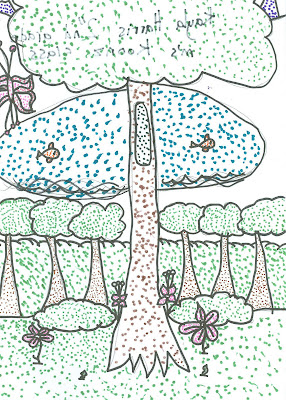
This is a student's example of a project I did with second grade on Georges Seurat and Pointillism. We read Getting to Know the World's Greatest Artists Georges Seurat by Mike Venezia. To remember the name of the style "Pointillism" I asked the students to point their index finger in there air every time we said "Pointillism!" The students filled in abubble map with Georges Seurat's masteripiece Sunday Afternoon on the Island of La Grande Jatte in the center. In each of the 10 bubbles the student wrote a fact they learned about Seurat and his art. We shared our maps as a class for art history review.
Wednesday, April 30, 2008
The Power of Siblings
Something I have been trying out recently is enlisting the help of older siblings of challenging students to help me understand and tame behavior issues. This is something that didn't work much at first for me, but as I have worked with the same community for three years the students are more respectful and responsive. I may ask a sibling a question like "What's your brother like at home?" or "Your brother was acting naughty yesterday in art, what's the best way to reach your parents?" By asking simple and general questions about the family and home life I can find out for example that "dad is tougher on discipline "or that "my parents are breaking up." Responsible older siblings can also help out when you cannot reach the parents.
Labels:
classroom management,
discipline,
instruction,
teacher,
teaching,
teaching skills
Monday, April 28, 2008
RAFT Activities
RAFT
Name: Liza Camhi
Grade Level & Content: 4th Grade Art
Title: Picasso vs. Matisse- The Showdown!
Power Standard(s)
(3)1.4 judge works of art, based on observed merits
a. share opinions
b. support opinions, points of view by citing artwork
(3)2.2 discuss materials, processes, purposes, e.g., learn how artist’s choices are
influenced by culture, time and place [NS 4.3.2]
Objectives:
Student will participate in a debate as to whether Cubist Pablo Picasso or Fauvist Henri Matisse created a stronger art style.
Kid-friendly Objectives/
Essential Questions:
Henri Matisse and Pablo Picasso were always competing with their art. Who was the better artist? Which one invented a better style?
Type of Differentiation
(readiness, interest, learning style):
Differentiated based on interest.
Le Salon
Poster/Advertisement
Entice Parisian artists to participate in a self-portrait contest to prove that their unique style is the best!
Name: Liza Camhi
Grade Level & Content: 4th Grade Art
Title: Picasso vs. Matisse- The Showdown!
Power Standard(s)
(3)1.4 judge works of art, based on observed merits
a. share opinions
b. support opinions, points of view by citing artwork
(3)2.2 discuss materials, processes, purposes, e.g., learn how artist’s choices are
influenced by culture, time and place [NS 4.3.2]
Objectives:
Student will participate in a debate as to whether Cubist Pablo Picasso or Fauvist Henri Matisse created a stronger art style.
Kid-friendly Objectives/
Essential Questions:
Henri Matisse and Pablo Picasso were always competing with their art. Who was the better artist? Which one invented a better style?
Type of Differentiation
(readiness, interest, learning style):
Differentiated based on interest.
Le Salon
Poster/Advertisement
Entice Parisian artists to participate in a self-portrait contest to prove that their unique style is the best!
Pablo Picasso
Lecture (written speech)
Convince the salon that cubism is better than fauvism by comparing/contrasting two works of art. One work should be a Picasso, one a Matisse, and both should be a self-portrait the artist created.
Lecture (written speech)
Convince the salon that cubism is better than fauvism by comparing/contrasting two works of art. One work should be a Picasso, one a Matisse, and both should be a self-portrait the artist created.
Henri Matisse
Lecture (written speech)
Convince the salon that fauvism is better than cubism by comparing/contrasting two works of art. One work should be a Picasso, one a Matisse, and both should be a self-portrait the artist created.
Critique
Persuade the world through your writing that either Cubism or Fauvism is the stronger art style. Use all five elements of art and your knowledge of the styles to support your decision.
Lecture (written speech)
Convince the salon that fauvism is better than cubism by comparing/contrasting two works of art. One work should be a Picasso, one a Matisse, and both should be a self-portrait the artist created.
Critique
Persuade the world through your writing that either Cubism or Fauvism is the stronger art style. Use all five elements of art and your knowledge of the styles to support your decision.
Article
Describe the opening reception for Le Salon’s art contest. Who on the contest and why? Who lost the contest and how did they react? Use your knowledge of both art styles and artists to support your findings.
Describe the opening reception for Le Salon’s art contest. Who on the contest and why? Who lost the contest and how did they react? Use your knowledge of both art styles and artists to support your findings.
Labels:
activities,
art,
centers,
choice,
creativity,
critique,
cross curricular,
elementary school,
group activities,
lesson plan,
RAFT,
teacher,
teaching,
unit plan
Friday, April 25, 2008
A Great Lesson for Paper Scraps!
I found this lesson online and thought it would be a fun end of the year or recycling project. Check it out:http://www.princetonol.com/groups/iad/lessons/middle/Linda-mask.htm
Labels:
art,
art club,
art education,
lesson plan,
masks,
paper,
steps of a lesson
Tuesday, April 22, 2008
Leonardo Da Vinci Think Tac Toe
THINKTACTOE: A CHOICE MENU
Grade Level & Content: Grade 4 Art
Power Standard(s)
(5)1.2 analyze works of art, e.g., compare and contrast the application of elements and
principles of design, etc. [NS 5.5.1]
(5)2.3 discuss artistic styles, e.g., define characteristics in works of art that identify
individual artists, groups of artists, or cultures [NS 4.5.2
Objective(s)
Student will use the elements of art and principals of design to critique (a) masterpiece(s) by Leonardo Da Vinci.
Student will classify works of art by Leonardo Da Vinci by their function (portrait, religious, science).
Student will list Da Vinci’s contributions to science, technology, and art.
Kid-friendly Objective(s) or Essential Question(s)
How did Leonardo use the elements of art and principal designs to create Mona Lisa and the Last Supper?
Leonardo had all sorts of purposes for creating art, how can I identify what the purpose of each artwork is?
I heard that Leonardo had a lot of ideas for art, science, and inventions. What were they?
THINKTACTOE: A CHOICE MENU
Directions to Students: Based on what we read in The Genius of Leonardo by Guido Visconti and Bimba Landmann choose three activities to complete.
Grade Level & Content: Grade 4 Art
Power Standard(s)
(5)1.2 analyze works of art, e.g., compare and contrast the application of elements and
principles of design, etc. [NS 5.5.1]
(5)2.3 discuss artistic styles, e.g., define characteristics in works of art that identify
individual artists, groups of artists, or cultures [NS 4.5.2
Objective(s)
Student will use the elements of art and principals of design to critique (a) masterpiece(s) by Leonardo Da Vinci.
Student will classify works of art by Leonardo Da Vinci by their function (portrait, religious, science).
Student will list Da Vinci’s contributions to science, technology, and art.
Kid-friendly Objective(s) or Essential Question(s)
How did Leonardo use the elements of art and principal designs to create Mona Lisa and the Last Supper?
Leonardo had all sorts of purposes for creating art, how can I identify what the purpose of each artwork is?
I heard that Leonardo had a lot of ideas for art, science, and inventions. What were they?
THINKTACTOE: A CHOICE MENU
Directions to Students: Based on what we read in The Genius of Leonardo by Guido Visconti and Bimba Landmann choose three activities to complete.
Use a circle map to share your knowledge of Da Vinci’s life, art, and inventions.
Design a bubble map using the six elements of art to critique the Mona Lisa.
Create a tree map that shows at least 10 of Da Vinci’s contributions to science, technology, and art.
Use a multi-flow map to show at least 3 ideas of inventions Da Vinci created and what modern day technologies are similar to his ideas.
Fill in a Frayer Diagram that lists the style/period of Leonardo’s artwork, the characteristics of the style/period, famous works of art, and his artistic inventions.
Design a bubble map using the six elements of art to critique the Mona Lisa.
Create a tree map that shows at least 10 of Da Vinci’s contributions to science, technology, and art.
Use a multi-flow map to show at least 3 ideas of inventions Da Vinci created and what modern day technologies are similar to his ideas.
Fill in a Frayer Diagram that lists the style/period of Leonardo’s artwork, the characteristics of the style/period, famous works of art, and his artistic inventions.
Make a flow chart to summarize at least 5 major events of Leonardo’s life.
Create a bubble map to explain the use of the all of the principals of design in analyze The Last Supper.
Create a tree map to classify at least 3 works of art by Leonardo Da Vinci as either portrait, religious, or scientific.
Create a tree map to classify at least 3 works of art by Leonardo Da Vinci as either portrait, religious, or scientific.
Design a double bubble map comparing/contrasting the use of the at least 3 elements of art in The Last Supper and Mona Lisa.
ArtCorps
I have been doing some research on teaching art abroad, and while this is not traditional classrom teaching it is a terrific experience. Artists go to Central American countries and use arts as a means of social change. This program sends artists for 1 year abroad to empower communities to improve their social, health, and environmental conditions through art. You do need to be fluent in Spanish.
http://www.artcorp.org
http://www.artcorp.org
Sorry!!!!
I am sorry i have not been posting due to illness and being off from work. I will put 2 new posts on today and hope it makes up for it!
Wednesday, April 9, 2008
Gyotaku Fish Printing
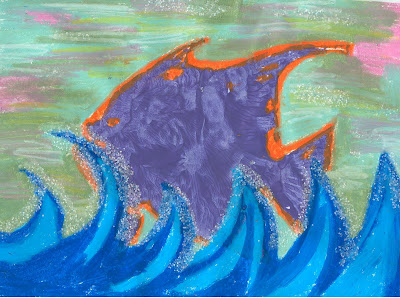
By Liza Camhi
Grade Level & Content: 3rd Grade Art
Title:Gyotaku Fish Printing
Power Standard(s)
(5)2.1 examine historical/cultural context, e.g., categorize works of art according to culture, time or place [NS 4.5.2]
(5)2.2 discuss materials, processes, purposes, e.g., learn how artist’s choices are influenced by time and place [NS 4.5.2]
(5)4.12 create a work of art that shows the influence of a particular historical period or culture [NS 4.5.3]
Objective(s)
Student will examine the reasons fish are an important subject matter in Japanese Art.
Student will create a Gyotaku print using similar methods to those of traditional Japanese prints.
Kid-friendly Objective(s) or Essential Question(s)
1. Why are their so many underwater and fish pictures in Japanese art?
2. If I were a Japanese fisherman, what fish would I catch and make prints of?
Pre-Assessment
KWLH chart. Students will share what they know, would like to know, think they know, and hypothesize about Japan, fish, and printmaking.
Final Assessment- Product: Gyotaku print completed
Whole Class Activities
1st Day: Student will examine the visual display of Gyotaku prints. Student will fill in the “What I already know ”and “What I think I know” sections of his/her KWLH chart. Student will answer the question “How do you think these pictures were made” in the “What I hypothesize section. Student will listen to the first half of the book Kogi's Mysterious Journey by Elizabeth Partridge. Student will fill further fill in the section “What I think I know” and create another hypothesis in their third column of his KWLH chart. The hypothesis should be an idea as to why fish are so important in Japanese art and culture based on reading the book.
2nd Day: Student will review previous knowledge about the use of fish in Japanese art from reading the book Kogi’s Mysterious Journey by Elizabeth Partridge. Student will listen to the second half of the book Kogi’s Mysterious Journey by Elizabeth Partridge. Student will listen to both a description of Gyotaku printing and watch a demonstration. Student will listen to an explanation of why fish are important to Japanese culture. Student will fill in “What I have learned” section further. Six students at a time will go to the red table and print their Gyotaku fish using ink and rubber fish model. Each student will bring an assistant to help them print. If he is not printing he can be a paint or sink helper.
3rd Day: Student will review the story Kogi’s Mysterious Journey by Elizabeth Partridge and the process/purpose of Gyotaku printing. Student will use oil pastels to color in the ocean and sky of their print. Student may add details of the fish with oil pastel. When student has completed coloring he may use a brush and glue to paint areas where he will add glitter.
Tiered Questions:
LITERAL QUESTIONS:
Who created these works of art- what job did they have and what was their nationality?
What is the purpose of the Gyotaku prints?
When did the Japanese begin making Gyotaku prints?
Where did the Japanese fisherman make their prints?
Analytic (Higher-level thinking) questions
How would you record your catch of the day other than by printing?
Why are fish so important in Japanese art and culture?
Should we use real animals or animal parts in art projects?
Task 2: Question(s) for each level of Bloom’s Taxonomy:
Remembering – What do Japanese fishermen use to make Gyotaku prints?
Understanding- Why do Japanese fisherman make Gyotaku prints?
Applying – If you were to record an object that you collect by printing it, what would it be?
Analyzing- Gyotaku prints are simple stamps of fish on white paper. As an artist what background and foreground elements would you add to make the print a narrative?
Evaluating- Gyotaku prints are meant to be useful, can they still be art?
Creating- As an artist how can you take a simple Gyotaku print and make it more visually dynamic?
Task 3: Divergent Question(s)
Fluency- How many uses can prints have? What would you print that may be useful?
Flexibility- How would you feel if you were a Buddhist monk that is a vegetarian and you were looking at this art? Would your beliefs allow you to accept the art or would you be against it for using a dead animal?
Involvement- How would you feel if you were the fish being used to make this art?
Reorganization (Provocative)- Since Japan is an Island surrounded by water, fish is a main source of food. If Japan were not an island, what type of land would it be? (arctic, desert, jungle) Based on your answer what animals and other ingredients from the land might they use to make food?
Whole Class Culminating/Sharing Activities
4th Day: Student will share his Gyotaku print with the class in a critique.
Procedures Used for Questioning
· Indicate the different ways you will use these questioning strategies to differentiate instruction. Several of the questions asked pertain to science and naturalist ways of thinking with regards to whether or not it is acceptable to use fish (and other animals) in art. Some of my questions are completely literal and rely on the students listening and reading skills. There are quite a few that ask the student what they would feel as a fish or a vegetarian and they are intrapersonal. Other intrapersonal questions have to do with what the student would collect and print other than fish. There is also an organizational/mathematical element in terms of using these prints to record and that is discussed in the questions. Only two questions rely on visual/spatial learning in terms of make the prints more visually dynamic and stylized.
Grade Level & Content: 3rd Grade Art
Title:Gyotaku Fish Printing
Power Standard(s)
(5)2.1 examine historical/cultural context, e.g., categorize works of art according to culture, time or place [NS 4.5.2]
(5)2.2 discuss materials, processes, purposes, e.g., learn how artist’s choices are influenced by time and place [NS 4.5.2]
(5)4.12 create a work of art that shows the influence of a particular historical period or culture [NS 4.5.3]
Objective(s)
Student will examine the reasons fish are an important subject matter in Japanese Art.
Student will create a Gyotaku print using similar methods to those of traditional Japanese prints.
Kid-friendly Objective(s) or Essential Question(s)
1. Why are their so many underwater and fish pictures in Japanese art?
2. If I were a Japanese fisherman, what fish would I catch and make prints of?
Pre-Assessment
KWLH chart. Students will share what they know, would like to know, think they know, and hypothesize about Japan, fish, and printmaking.
Final Assessment- Product: Gyotaku print completed
Whole Class Activities
1st Day: Student will examine the visual display of Gyotaku prints. Student will fill in the “What I already know ”and “What I think I know” sections of his/her KWLH chart. Student will answer the question “How do you think these pictures were made” in the “What I hypothesize section. Student will listen to the first half of the book Kogi's Mysterious Journey by Elizabeth Partridge. Student will fill further fill in the section “What I think I know” and create another hypothesis in their third column of his KWLH chart. The hypothesis should be an idea as to why fish are so important in Japanese art and culture based on reading the book.
2nd Day: Student will review previous knowledge about the use of fish in Japanese art from reading the book Kogi’s Mysterious Journey by Elizabeth Partridge. Student will listen to the second half of the book Kogi’s Mysterious Journey by Elizabeth Partridge. Student will listen to both a description of Gyotaku printing and watch a demonstration. Student will listen to an explanation of why fish are important to Japanese culture. Student will fill in “What I have learned” section further. Six students at a time will go to the red table and print their Gyotaku fish using ink and rubber fish model. Each student will bring an assistant to help them print. If he is not printing he can be a paint or sink helper.
3rd Day: Student will review the story Kogi’s Mysterious Journey by Elizabeth Partridge and the process/purpose of Gyotaku printing. Student will use oil pastels to color in the ocean and sky of their print. Student may add details of the fish with oil pastel. When student has completed coloring he may use a brush and glue to paint areas where he will add glitter.
Tiered Questions:
LITERAL QUESTIONS:
Who created these works of art- what job did they have and what was their nationality?
What is the purpose of the Gyotaku prints?
When did the Japanese begin making Gyotaku prints?
Where did the Japanese fisherman make their prints?
Analytic (Higher-level thinking) questions
How would you record your catch of the day other than by printing?
Why are fish so important in Japanese art and culture?
Should we use real animals or animal parts in art projects?
Task 2: Question(s) for each level of Bloom’s Taxonomy:
Remembering – What do Japanese fishermen use to make Gyotaku prints?
Understanding- Why do Japanese fisherman make Gyotaku prints?
Applying – If you were to record an object that you collect by printing it, what would it be?
Analyzing- Gyotaku prints are simple stamps of fish on white paper. As an artist what background and foreground elements would you add to make the print a narrative?
Evaluating- Gyotaku prints are meant to be useful, can they still be art?
Creating- As an artist how can you take a simple Gyotaku print and make it more visually dynamic?
Task 3: Divergent Question(s)
Fluency- How many uses can prints have? What would you print that may be useful?
Flexibility- How would you feel if you were a Buddhist monk that is a vegetarian and you were looking at this art? Would your beliefs allow you to accept the art or would you be against it for using a dead animal?
Involvement- How would you feel if you were the fish being used to make this art?
Reorganization (Provocative)- Since Japan is an Island surrounded by water, fish is a main source of food. If Japan were not an island, what type of land would it be? (arctic, desert, jungle) Based on your answer what animals and other ingredients from the land might they use to make food?
Whole Class Culminating/Sharing Activities
4th Day: Student will share his Gyotaku print with the class in a critique.
Procedures Used for Questioning
· Indicate the different ways you will use these questioning strategies to differentiate instruction. Several of the questions asked pertain to science and naturalist ways of thinking with regards to whether or not it is acceptable to use fish (and other animals) in art. Some of my questions are completely literal and rely on the students listening and reading skills. There are quite a few that ask the student what they would feel as a fish or a vegetarian and they are intrapersonal. Other intrapersonal questions have to do with what the student would collect and print other than fish. There is also an organizational/mathematical element in terms of using these prints to record and that is discussed in the questions. Only two questions rely on visual/spatial learning in terms of make the prints more visually dynamic and stylized.
Labels:
art,
art criticism,
art education,
art history,
critique,
essential questions,
gyotaku,
japan,
japanese,
japanese art,
questioning
Tuesday, April 8, 2008
Interesting Multicultural Lesson
I really liked the way this mandala is constructed using simple materials. It can also be used for a dreamcatcher project or a medicine wheel. http://www.saxarts.com/resources/lessonPlans/viewLessonPlan.jsp?lp=135
Labels:
art,
art club,
art education,
art history,
art museum,
children,
cultures,
lesson plan,
mandalas,
multicultural,
multimedia
Sunday, April 6, 2008
Heads Down, Mouths Quiet
I don't know about you, but my students have spring fever. They are chatty, moving around, pinching eachother, tossing art supplies around, bascially my room has been mayhem coming back from spring break. The first week it was like this, I took the materials away and told my students to put their heads down and not talk for the rest of the period. This helped immensely, by the second week back they were beginning to straighten up. Another trick I pulled was telling each class when they came in how naughty the other classes had been and how they lost their priveledges. Try this out next full moon.
Labels:
behavior management,
classroom management,
discipline,
teacher,
teaching
Thursday, April 3, 2008
Trayola
Check out the Trayola by Crayola markers and crayons. They come with their own case, so you jest set them out as is. They do the organizing for you!
Labels:
art supplies,
brands,
crayola,
crayons,
markers,
organizing,
supplies
A Financial Tip
I recently read Suze Orman's book "Fabulous, Young, and Broke" and the main lesson I learned is to invest in real estate. I am a single woman under 30, but the housing market is a buyer's market right now. It's a good time to invest. As a teacher, it's smart to take advantage of these opportunities.
Tuesday, April 1, 2008
Directions Flow Chart
In art sometimes there are several steps to a project. Yes we can try to break it up, but if the steps are small already you can ask your students to make a directions flow chart to keep at their seat. This way they have both gone over the directions by hearing them, writing them, and seeing them. This gives students more independence.
Monday, March 31, 2008
Native Designs at the Hoover Dam





Last week was spring break for me and one of my friends came into town. She doesn't like the strip and clubs, etc. so this was more of a nature trip. On our excursions we took the Hoover Dam tour and inside of the dam are native american designs based on southwestern pottery all over the floor. Check them out.
Labels:
hoover dam,
las vegas,
native american,
pottery,
southwestern art
Friday, March 28, 2008
A Sense of Humor
Especially in sticky situations where emotions are running high, a sense of humor can help. Even a sense of acceptance. I have had to diffuse situations by making a joke or just "understanding." It can stop a fight from happening or someone's feelings from being hurt.
Wednesday, March 26, 2008
Bloom's Taxonomy for Art
I'm currently working on my second master's project for a course i'm taking in differentiated instruction. We are developing questioning strategies and I have found it really inspiring. I've started adding essential questions to all of my lessons and the kids are really intrigued! Here's a website that ties Bloom's Taxonomy into art criticism, check it out: http://www.princetonol.com/groups/iad/Files/blooms2.htm
Tuesday, March 25, 2008
Community Based Art Education
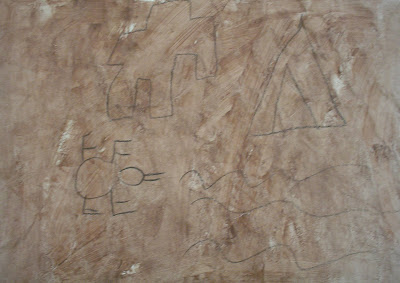
This fall I did a unit plan on arts in Las Vegas. With second grade we examined the petroglyphs in Red Rock Canyon. To create their work students wrote a story using 4-5 petroglyphs on white 11"x14" paper using black crayon. Afterwards we sponged watered-down brown paint all over our paper and crumpled it up before it dried. That created a rocky effect.
Tuesday, March 18, 2008
Matisse Red Rooms
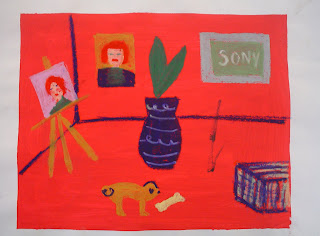
Miss Liza Camhi
Art Lesson Plan~Matisse Red Rooms
Grade(s): 3rd# of sessions: 3
Art Resources:~ teacher product, Red Room (Interiors, Studio)paintings by Henri Matisse, Getting to Know the World’s Greatest Artists: Henri Matisse by Mike Venezia, and elements of art cube.
Art Materials: 1 sheet of 11”x14” white paper per student, red paint, masking tape, pencils, erasers, 8”x10” sketch paper, red tempera paint, large paintbrushes, smocks, and oil pastels.
Major Goals/N.V.~ State Standards addressed in this lesson:
1.0 Students know and apply visual arts media, techniques, and processes.
4.0 Students understand the visual arts in relation to history and cultures.
5.0 Students analyze and assess characteristics, merits, and meanings in their artwork and the work of others.
Essential Concepts, Skills, and Experiences- 3rd Grade1.2, 1.5, 2.3, 4.1,and 4.11
Objectives- Student will:
*critique the Red Room paintings using the elements of art.
* evaluate his work in relation to the influence of Matisse’s Red Room paintings, the elements of art, and craft.
*engage in historical inquiry to answer why Matisse used color so boldly and vibrantly (especially red).
*use his knowledge of how Henri Matisse used the elements of art to create his own artwork in the style of Matisse.
*use paint and oil pastel together to create an original work of art.
* evaluate his work in relation to the influence of Matisse’s Red Room paintings, the elements of art, and craft.
*engage in historical inquiry to answer why Matisse used color so boldly and vibrantly (especially red).
*use his knowledge of how Henri Matisse used the elements of art to create his own artwork in the style of Matisse.
*use paint and oil pastel together to create an original work of art.
Relation to life/Why this lesson is important: Student will evaluate the use of the elements of art in a master artist’s work and use that knowledge to create an original work of art.
Interdisciplinary Connections: History
Vocabulary: Henri Matisse, elements of art (shape, line, color, space, and texture), composition, color scheme.
Procedure: Day 1: Student will participate in a game/discussion about the Red Room paintings by Henri Matisse. Student will toss the elements of art cube to a peer, whichever elements faces up the student must relate to the Red Room paintings. Student will listen to teacher read Getting to Know the World’s Greatest Artists: Henri Matisse by Mike Venezia pgs. 3-12. (Essential Question 1) Student will view teacher product and discuss project. Student will create a sketch of a room in pencil on 8”x10” white paper. The room must contain at least 4 elements (works of art, furniture, technology) Day 2: Student will review vocabulary and the previous weeks reading.~ Student will listen to teacher read Getting to Know the World’s Greatest Artists: Henri Matisse by Mike Venezia pgs 13-23. (Essential Questions 4-6) Student will review the teacher product. Student will view a demonstration on how to tape the edges of his work for painting. Student will tape the edges of his 11”x14” paper and paint red tempera inside the masked area. Day 3: Student will review vocabulary and the previous week’s reading.~ Student will listen to teacher finish reading Getting to Know the World’s Greatest Artists: Henri Matisse by Mike Venezia. Essential Questions (7-9). Student will review the teacher product and directions for the project. Student will watch a demonstration on how to use oil pastel to draw and color his picture in (add perspective). Student will draw and color his 4+ room elements in with oil pastel. Student will bring his picture to the teacher for critique and grade.
Essential Questions:
1. How would you feel if you were Henri Matisse when his father would not support his decision to be an artist?
2. Do you like how Matisse made his rooms so brightly red? Why or why not?
3. Would you like your bedroom to be bright red? Why or why not?
4. Why was Matisse called a wild beast?
5. How do you think Matisse felt about being called a wild beast?
6. How would you feel if you were Matisse and because of the way you painted someone called you a wild beast?
7. In Harmony in Red what areas look 3-d and what areas look flat?
8. In the Red Studio what colors other than red did Matisse use?
9. Why do you think as he got older his paintings got brighter?
Sunday, March 16, 2008
Animal Masks
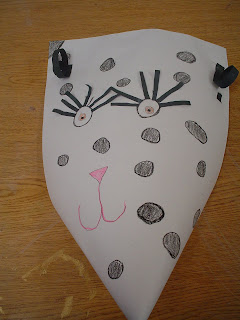
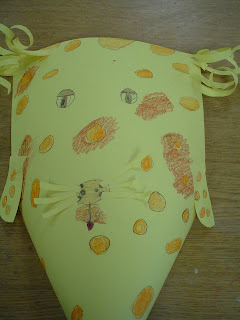
While I was student teaching I learned a great way to make paper masks. The students color, cut and paste the features they want to add to their mask on an 11"x14" sheet of construction paper. Afterwards I fold the bottom corners in and staple. I do this project in 3 weeks: the first they sketch their idea, the second they draw and color on the construction paper, and on the third they cut and paste parts that stick out (ears, hair, whiskers, etc). I do this project with second grade and they love the final product!
Labels:
animals,
art,
art club,
art education,
art program,
art room,
crafts,
creativity,
cross curricular,
masks,
paper
Friday, March 14, 2008
Clay Cartouches
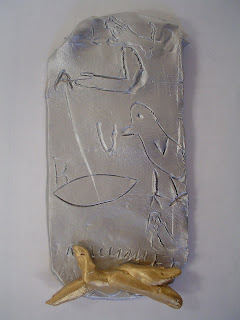
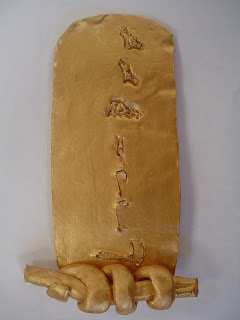
These are two of the finished clay cartouches made by my art clubbers. 5th and 4th grade could easily do it, 3rd struggled with carving the letters and creating the scroll at the bottom. I am really impressed with how they cam out, nevertheless. After the entire Egypt unit one of my students was asked where Egypt is and he pointed to the art room and said "There!" Ofcourse Africa would have been more appropriate, but it put a smile on my face!
Labels:
art,
art club,
art education,
art history,
art museum,
art program,
art room,
cartouch,
ceramics,
clay,
egyptian art,
elementary school,
exhibit
Wednesday, March 12, 2008
Matroyshka Doll Lesson
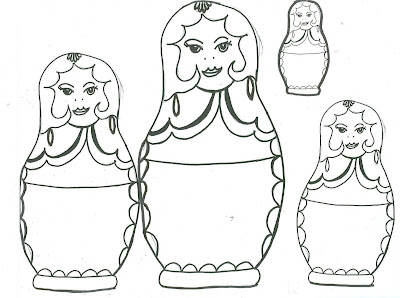
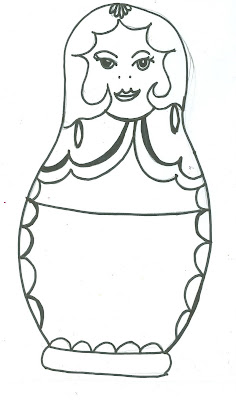
This lesson plan was a huge success for my sub last month! I have attached the Russian Doll Templates.
Sub Lesson Plan
Russian Matroyshka Dolls
Materials: Crayons and scissors (in the red boxes at each table), 11”x14” construction paper, and glue sticks.
Resources: Matroyshka Doll handouts, teacher exemplar, A Look at Russia by Helen Frost, and Russia ABC’s by Ann Berge.
Procedures
*Show students the teacher exemplar and tell them these are Russian Matroyshka dolls. Explain them they are also called nesting dolls, because they fit inside each other.
*Read A Look at Russia by Helen Frost and pg 7. in Russia ABC’s.
*Pass out both Matroyshka Doll handouts and have students color in their dolls using crayons. They need to create a different pattern inside each doll.
*Students who finish coloring their dolls can cut them out and glue them onto and 11”x14” sheet of construction paper (they can pick the color). Make sure to go over with them to only use the glue around the edge of the doll, otherwise they will use too much and the glue sticks will go fast.
Tuesday, March 11, 2008
Arts4Nevada
This is an arts advocacy website that supporst arts in Nevada. There are many ways to take action and contact legislators to support arts programs. Check it out and sign up to take action!http://arts4nevada.org/index.html
Monday, March 10, 2008
Friday, March 7, 2008
An Excellent Resource
This is a great resource for art specialists. There are all sorts of links to other sites with art, art history, museums, architecture, photography, and lesson plans! http://www.nhptv.org/kn/vs/artlaba.htm
Labels:
art,
art education,
art program,
instruction,
lesson plan,
teacher,
teaching,
unit plan,
websites
Wednesday, March 5, 2008
Dunkin Donuts Art Contest
Dunkin Donuts is hosting an art contest for kids. https://www.dunkindonuts.com/contests/heroes.aspx?cid=3215930&jid=4071356&mc=179&eid=889773&utm_source=PERKS_MAR5&utm_medium=EMAIL&utm_campaign=PERKS_030508_ENROLLED#The winning artwork will be illustrustrated on a card and $500 dollars will be donated to the charity of the winner's choice.
Tuesday, March 4, 2008
Questioning
I'm currently taking a course in differentiated instruction at UNLV. Right now we are focusing on questioning skills as teachers. My next lesson plan project must include questions that relate to Bloom's Taxonomy, are divergent, and literal. Check out this link to provoke better questioning http://questioning.org/Q7/toolkit.html I will be sure to post the project on the blog as soon as it is finished.
Friday, February 29, 2008
Differentiated Frida Kahlo Lesson
Name Liza Camhi
Strategy: Multiple Intelligences or Triarchic Model
TIERED Instructional Project #1
Grade Level & Content: 5 Art
Title: Frida’s Story Through her Art
Power Standard(s) It is expected student will:(5) 2.3 discuss artistic styles, e.g, define characteristics in works of art that identify individual artists, groups of artists, or cultures (NS 4.5.2)(5) 2.6 engage in art historical research/inquiry, e.g., find answers to questions about an art object’s time, place or people by examining images, reading, listening, etc. (NS 4.5.2)
Objective(s)-Student will relate the symbolism (hair cut off, Mexican motifs, heart surgery, and pets) found in Frida Kahlo’s artwork to the artist’s life.-Student will listen to and discuss the main events of Getting to Know the World’s Greatest Artist’s: Frida Kahlo by Mike Venezia.-Student will identify the events of the artist’s life as they are revealed in Frida Kahlo’s self-portraits through a group project.
Kid-friendly Objective(s) or Essential Question(s)1. How does an artist paint his /her autobiography?2. How would I paint my autobiography?3. What are the important events in my life that I would want to show in my self-portrait?4. How can I figure out what the artist is trying to say in his/her artwork?
Pre-Assessment KWHL table: What do I already know?, What do I think I know?, What did I learn?, What do I want to learn?
Final Assessment: Group: The Task Activities will be graded by rubric. Individually: A fill in the blank test on the life and art of Frida Kahlo. (20 questions)
Whole Class Activities- (visual/spatial, verbal/linguistic, interpersonal, intrapersonal)
Day 1: The teacher will display Frida Kahlo’s Self-Portrait with a Monkey for the class. The class will discuss what they know previously about the artist and this artwork from the project they did in second grade. The student will fill in his/her KWHL chart (What do I already know?) (What do I think I know?) and share his answers with the group. The student will listen to a reading of Getting to Know the World’s Greatest Artists: Frida Kahlo by Mike Venezia pgs. 3-19. The student will fill in his “What have I learned?” section based on the day’ reading and share his answers with the class.
Day 2: The class will review discuss the previous weeks reading. The student will listen to Getting to Know the World’s Greatest Artists: Frida Kahlo by Mike Venezia pgs. 20-32. The student will finish filling in his “What have I learned?” section of his KWLH chart and share his answers with the class. The student will write at least two items in the section “What do I want to learn?” in his KWHL chart. The student will listen to an explanation of the 5 task activities he can choose from. He will fill in a choice questionnaire and list his favorite task activities from 1-5. Day 3: The student will be assigned to his task group. The teacher will give specific jobs to each member of the group.
Task 1 Activities (Group) Group will create an illustrated timeline of the artist’s life. The timeline must include important events in the artist’s life and explain how they influenced specific works of art created by Frida Kahlo. There must be a minimum of 7 illustrations of to go along with the timeline. (logical/mathematical, verbal/linguistic, interpersonal, visual/spatial)
Task 2 Activities (Group) Group will create an original Frida Kahlo self-portrait poster that describes an important event in the artist’s life. The poster must represent the style in which Frida Kahlo created her art.
(interpersonal, visual/spatial)
Task 3 Activities (Group) Group will write and perform a five- seven minute skit based on a period of the artists life. The skit must include three major events that influenced the artist’s work.
(bodily/kinesthetic, verbal/linguistic, interpersonal)
Task 4 Activities (Group) Group will work individually on a journal entry in the voice of Frida Kahlo. The student must write 3 paragraphs describing an event in Frida Kahlo’s life as if it happened that day. The student must describe how they would feel if they Frida Kahlo on that particular day. (verbal/linguistic, interpersonal, intrapersonal)
Whole Group Sharing: Task 1 Group will share their timeline with the class, read the events, and explain their illustrations. Task 2 Group will show their poster to the class describing how they were influenced by the artist’s life and style in their poster. Task 3 group will perform their skit for the class. The students in Task 4 group will share within their group by exchanging their work with a partner to read and critique.
Group Expectations: 1. Students will create their project within 2-3 class periods. 2. Students will perform their roles in order to keep arguing to a minimum and make the group functional. 3. Each student will participate equally.·
Type of Flexible grouping: By level of interest. The interest choice should indicate to some degree if the student is logical/mathematical (group 1), visual/spatial (group 2), bodily/ kinesthetic(group 3), or intrapersonal (maybe verbal/linguistic as well) (group 4). To some degree all groups are interpersonal, even group 4.·
Formation of groups, i.e., how students are assigned to groups: 5-6 Students will be assigned to each group based on their level of interest in the activity.·
Roles of group members, e.g., Recorder: Task Manager, Voice Controller, Sketch Artist (task 1&2), Clean Up Kids, Teacher Liaison, Time Keeper.·
Directions to Groups, i.e., how students know their learning tasks: The tasks will be explained to the groups prior to being assigned to a group. There will be laminated directions at each group’s workspace.·
Anchor Activity: Student will create a self-portrait describing an important event in their life. (intrapersonal, visual/spatial)
Strategy: Multiple Intelligences or Triarchic Model
TIERED Instructional Project #1
Grade Level & Content: 5 Art
Title: Frida’s Story Through her Art
Power Standard(s) It is expected student will:(5) 2.3 discuss artistic styles, e.g, define characteristics in works of art that identify individual artists, groups of artists, or cultures (NS 4.5.2)(5) 2.6 engage in art historical research/inquiry, e.g., find answers to questions about an art object’s time, place or people by examining images, reading, listening, etc. (NS 4.5.2)
Objective(s)-Student will relate the symbolism (hair cut off, Mexican motifs, heart surgery, and pets) found in Frida Kahlo’s artwork to the artist’s life.-Student will listen to and discuss the main events of Getting to Know the World’s Greatest Artist’s: Frida Kahlo by Mike Venezia.-Student will identify the events of the artist’s life as they are revealed in Frida Kahlo’s self-portraits through a group project.
Kid-friendly Objective(s) or Essential Question(s)1. How does an artist paint his /her autobiography?2. How would I paint my autobiography?3. What are the important events in my life that I would want to show in my self-portrait?4. How can I figure out what the artist is trying to say in his/her artwork?
Pre-Assessment KWHL table: What do I already know?, What do I think I know?, What did I learn?, What do I want to learn?
Final Assessment: Group: The Task Activities will be graded by rubric. Individually: A fill in the blank test on the life and art of Frida Kahlo. (20 questions)
Whole Class Activities- (visual/spatial, verbal/linguistic, interpersonal, intrapersonal)
Day 1: The teacher will display Frida Kahlo’s Self-Portrait with a Monkey for the class. The class will discuss what they know previously about the artist and this artwork from the project they did in second grade. The student will fill in his/her KWHL chart (What do I already know?) (What do I think I know?) and share his answers with the group. The student will listen to a reading of Getting to Know the World’s Greatest Artists: Frida Kahlo by Mike Venezia pgs. 3-19. The student will fill in his “What have I learned?” section based on the day’ reading and share his answers with the class.
Day 2: The class will review discuss the previous weeks reading. The student will listen to Getting to Know the World’s Greatest Artists: Frida Kahlo by Mike Venezia pgs. 20-32. The student will finish filling in his “What have I learned?” section of his KWLH chart and share his answers with the class. The student will write at least two items in the section “What do I want to learn?” in his KWHL chart. The student will listen to an explanation of the 5 task activities he can choose from. He will fill in a choice questionnaire and list his favorite task activities from 1-5. Day 3: The student will be assigned to his task group. The teacher will give specific jobs to each member of the group.
Task 1 Activities (Group) Group will create an illustrated timeline of the artist’s life. The timeline must include important events in the artist’s life and explain how they influenced specific works of art created by Frida Kahlo. There must be a minimum of 7 illustrations of to go along with the timeline. (logical/mathematical, verbal/linguistic, interpersonal, visual/spatial)
Task 2 Activities (Group) Group will create an original Frida Kahlo self-portrait poster that describes an important event in the artist’s life. The poster must represent the style in which Frida Kahlo created her art.
(interpersonal, visual/spatial)
Task 3 Activities (Group) Group will write and perform a five- seven minute skit based on a period of the artists life. The skit must include three major events that influenced the artist’s work.
(bodily/kinesthetic, verbal/linguistic, interpersonal)
Task 4 Activities (Group) Group will work individually on a journal entry in the voice of Frida Kahlo. The student must write 3 paragraphs describing an event in Frida Kahlo’s life as if it happened that day. The student must describe how they would feel if they Frida Kahlo on that particular day. (verbal/linguistic, interpersonal, intrapersonal)
Whole Group Sharing: Task 1 Group will share their timeline with the class, read the events, and explain their illustrations. Task 2 Group will show their poster to the class describing how they were influenced by the artist’s life and style in their poster. Task 3 group will perform their skit for the class. The students in Task 4 group will share within their group by exchanging their work with a partner to read and critique.
Group Expectations: 1. Students will create their project within 2-3 class periods. 2. Students will perform their roles in order to keep arguing to a minimum and make the group functional. 3. Each student will participate equally.·
Type of Flexible grouping: By level of interest. The interest choice should indicate to some degree if the student is logical/mathematical (group 1), visual/spatial (group 2), bodily/ kinesthetic(group 3), or intrapersonal (maybe verbal/linguistic as well) (group 4). To some degree all groups are interpersonal, even group 4.·
Formation of groups, i.e., how students are assigned to groups: 5-6 Students will be assigned to each group based on their level of interest in the activity.·
Roles of group members, e.g., Recorder: Task Manager, Voice Controller, Sketch Artist (task 1&2), Clean Up Kids, Teacher Liaison, Time Keeper.·
Directions to Groups, i.e., how students know their learning tasks: The tasks will be explained to the groups prior to being assigned to a group. There will be laminated directions at each group’s workspace.·
Anchor Activity: Student will create a self-portrait describing an important event in their life. (intrapersonal, visual/spatial)
Thursday, February 28, 2008
Portraits of Women
This is a video that shows over 200 years of female portraiture. It's from the Saatchi Gallery in London. It's a beautiful video and makes the viewer realize how differently the same subject can be construed.
http://www.saatchi-gallery.co.uk/blogon/mtvideobox.php?video_id=78
http://www.saatchi-gallery.co.uk/blogon/mtvideobox.php?video_id=78
Labels:
art,
art club,
art criticism,
art education,
art history,
art museum,
art program,
london,
portraiture,
Saatchi
Wednesday, February 27, 2008
Art Buyers
An art critique exercise I have that is really fun and engaging is asking students to be art buyers. I tell them that they are in the market for a work of art. They must estimate how much a series of paintings cost and back up their answers. If they say a painting is worth a million dollars, they need to tell me something art historical or critical to explain their answer. You can use fake money and set up a gallery walk to really give the exercise more interest.
Tuesday, February 26, 2008
Coffee Art




Another art educator in CCSD posted these pics on interact. My kids got a real kick out of them!
There
is a restaurant in Vancouver ..actually
three where they dress up the lattes.
You get to watch them create the pictures.
What can be done with coffee, cream, milk &
imagination?
There
is a restaurant in Vancouver ..actually
three where they dress up the lattes.
You get to watch them create the pictures.
What can be done with coffee, cream, milk &
imagination?
Labels:
art,
art criticism,
art education,
art program,
art room,
coffee art,
coffee.,
creativity,
teacher,
teaching
Monday, February 25, 2008
Thursday, February 21, 2008
Sorry I Haven't Posted!
I took the week off from work (at 12 month schools we can pick and choose our time off) and thought I would have all this time to gather cool info. My parents are in town and unfortunately it has limited my time (we're doing the whole tourist thing). I will be posting on Monday. Sorry for the inconvenience.
Monday, February 18, 2008
Regarding the Growth in Clark County
I have been one of the numerous teachers to be employed by the Clark County School District. I feel extremely fortunate to do the work I love and have so much opportunity to move ahead in my career here. If you are looking for a job in education I highly reccommend Las Vegas. If you live in an area in which there is little growth the easiest way to find a job is by applying to one of the faster growing school districts in the country. New York City, Texas, Los Angelas, Chicago, the Carolinas and Maryland are looking for teachers. Here's a good article I found regarding the growth in Clark County: http://www.edutopia.org/full-house
Labels:
education,
income,
instruction,
job search,
population,
teacher,
teaching
Saturday, February 16, 2008
Feedback 98
I would appreciate any feedback regarding this blog in order for me to put more useful information on it. Why do you come to this site, how did you find the blog, what would you like to see more of? Let me know at LCSC1980@aol.com Thank you!
Thursday, February 14, 2008
Doodle for Google
This is an amazing contest that Google is holding! The rules are that school aged children create a logo for Google with the theme of "What if..." The winner will collect a $10,000 college scholarship. For more information check out this link:http://www.msnbc.msn.com/id/23143437/
Labels:
art,
art contest,
art education,
art program,
art show,
college scholarship,
contest,
google
Wednesday, February 13, 2008
Jennifer Maestre
These sculptures are incredible! Imagine what they could inspire kids to make with found objects?
http://www.jennifermaestre.com/pencil_show.html
http://www.jennifermaestre.com/pencil_show.html
Labels:
art,
art club,
art program,
artist,
found objects,
jennifer maestre,
lesson plan,
pencil sculptures,
surrealism,
unit plan
Tuesday, February 12, 2008
Gyotaku Printing
When I received some extra money for my program I wasn't sure what to get with it. It wasn't a ton of money, so it wasn't like I could get lots of stuff. I definantly wanted something special that I would not get with the budget or pay for out of my own pocket (a little too pricey). I ended up getting these Gyotaku Fish Printing Replicas from Dick Blick. http://www.dickblick.com/zz429/07/ I absolutely love asian art and have not done enough with it. These were on sale 50% off at the Dick Blick store. I am going to do these prints in conjunction with Japanese Windsocks.
Here are some links about gyotaku fish printing:
http://freshaquarium.about.com/cs/funstuff/a/gyotaku.htm
http://gyotakumaui.com/
http://artsedge.kennedy-center.org/content/3436/ This one is a lesson plan!
Here are some links about gyotaku fish printing:
http://freshaquarium.about.com/cs/funstuff/a/gyotaku.htm
http://gyotakumaui.com/
http://artsedge.kennedy-center.org/content/3436/ This one is a lesson plan!
Labels:
art,
art education,
art program,
fish printing,
gyotaku,
multicultural,
printmaking,
supplies
Monday, February 11, 2008
On a Positive Note...
I've been talking to the itinerant art teacher at my school, Melissa Kehr. I asked her what about her first year of teaching art has been the most satisfying. She listed the joy she gets when her students learn something. She also loves the fact that she has fun at her job. As I get more experienced the growth I have as a teacher in terms of behavior management, planning lessons and units that make the kids get excited about learning art, and seeing the kids benefit from my program over the years have given me such joy.
Labels:
art,
art education,
art program,
education,
elementary school,
instruction,
teacher,
teaching
Sunday, February 10, 2008
Promoting Your Art Program
I know I have spoken before about promoting my art program with parents, now I am going to discuss my experience with promoting in the community. For a year and a half my students have had their work on permanent display at a local grocery store, this was set up through a parent who works there (see how awesome parents can be!) This year I have done 3 contests. The McCarren airport contest, Housing Divisions "Where I Live Contest," and the Crayola Art of Childhood contest. With the Housing Division's contest one of my students was a runner up and two other students had their artwork displayed at the Venetian. The governor's wife Dawn Gibbons was on hand during the event. My student who was a runner up received a gift certificate for art supplies as did I for my school. I also just wrote my first application for a grant, a small grant, but excellent experience. On Friday I received a check in the mail from City Lights Artists Co-Op. In the future I would like to have local buisnesses and casinos hang our artwork and continue writing for grants. The more you promote your program, the more it benefits.
Labels:
art,
art education,
art gallery,
art museum,
art program,
art show,
buisness,
casino,
certificates,
grants,
promotion,
Venetian
Wednesday, February 6, 2008
Arts Are Important!
If it had not been for Ms. Simonds I don't know that I would be a successful, happily employed person. She was my high school art teacher. Until high school I could not justify to my family how important art was to me. They wanted me to be an athlete and have great report cards. I wanted to stay in my room and draw all the time. In high school Ms. Simonds connected me to Locust St. Neighborhood Art Classes, Inc. I had my own studio space and professional artists critiquing my work when I was 16. My senior year it was the artists that explained to my dad why a job at the pizzeria would not be as beneficial to me in the long run as taking classes and working in my studio 4 days a week. That is how I got my portfolio together and got into art school. I am living proof that art gives a child a voice, a sense of self, an identity, and can be a tool for teaching cultures, math, science, and history. If those connections that I made as a teenager had not taken place I doubt I would be working in the arts today. That idea truly scares me because there is nothing else I would rather do. Here are some great websites about the importance of arts education:
http://www.statenislandarts.org/artsineducation/whytitle.html
http://www.kinderart.com/artspeak/important.shtml
http://www.statenislandarts.org/artsineducation/whytitle.html
http://www.kinderart.com/artspeak/important.shtml
Tuesday, February 5, 2008
Texture Rubbings
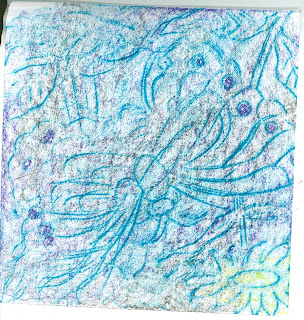
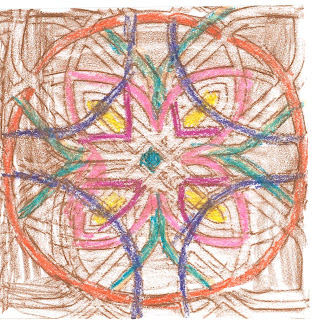
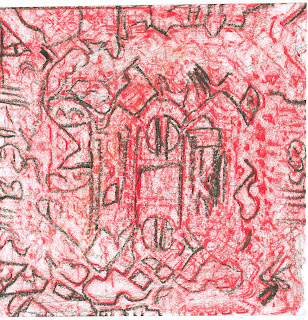
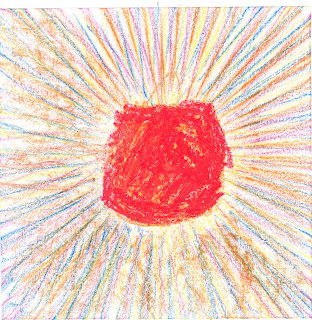
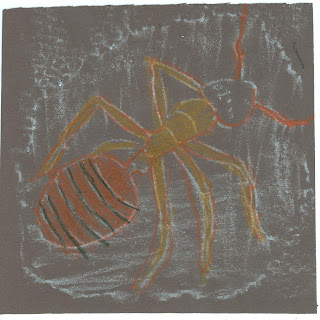
I cut 6"x6' sheets of construction paper and the students in second grade did texture rubbings using plastic texture mats and crayons. I asked them to work back in with the crayons. This assignment is part of a unit on the Elements of Art.
Labels:
art,
art education,
crayons,
elementary school,
elements of art,
lesson plan,
rubbings,
texture,
unit plan
Monday, February 4, 2008
Promoting Yourself as an Artist
Here are some sites to check out for promoting your artwork. You could add them to your resume, or put them on your buisness card that you hand out at interviews. Other ways to get noticed as an artist? Always check out Call for Work or Call for Artist ads online or in your local paper. My work is on etsy and myspace.
http://www.etsy.com
http://myartspace.com/
http://www.fineartamerica.com
http://fineartamerica.com/index.html
http://www.artscuttlebutt.com/
http://www.etsy.com
http://myartspace.com/
http://www.fineartamerica.com
http://fineartamerica.com/index.html
http://www.artscuttlebutt.com/
Saturday, February 2, 2008
Kente Cloth Lesson 2nd Grade
Art Lesson Plan
Kente Cloth
Grade: 2nd and 3rd# of sessions: 3
Art Resources: The Spider Weaver by Maragret Musgrove, teacher product, and visual aide.
Art Materials: one 8”x11” sheet of white paper per student; pencils; erasers; strips of construction paper cut 3” wide in red, green, orange, and yellow; and crayons.
Objectives- Student will:
- create a paper replica of Kente cloth.
- use pencils and crayons.
- choose and arrange various Kente cloth patterns in their replica.
- learn about the culture and art of Africa.
Relation to life/Why this is important: Student will learn about the cultural arts of another continent. Student will create a work of art based on literature.
Interdisciplinary Connections: English and Social Studies
Vocabulary: Kente cloth, Africa, Pattern,and Principals of Design.
Procedure: Day 1: Teacher will introduce the read The Spider Weaver: A Legend of Kente Cloth by Margaret Musgrove. Student will view the visual aide/teacher product and learn vocabulary terms. Student will discuss what a Kente cloth and pattern are. Student will be presented with the Principals of Design. The teacher will demonstrate how to draw a pattern using examples of Kente cloth patterns. Student will draw his pattern on two strips of construction paper using pencil.
Day 2: Student will review vocabulary and teacher product/visual aide. Student will begin coloring in pattern. Student will sketch another pattern on two more strips of paper.
Day 3: Student will review vocabulary and teacher product/visual aide. Student will review critique questions. Student will finish coloring his pattern and glue four strips in an alternating sequence on his 8”x11” sheet of paper.
Criteria
Excellent
Satisfactory
Needs Improvement
Student displayed following directions by drawing a Kente cloth pattern on two strips of paper of the same color.
Student displayed following directions by drawing a Kente cloth pattern on two strips of paper of the same color.
Student drew a Kente cloth pattern on two strips of paper not of the same color.
Student did not draw Kente cloth pattern.
Student pasted strips onto 8”x11” sheet of paper in an alternating color sequence .
Student pasted strips onto 8”x11” sheet of paper in an alternating color sequence ..
Student pasted strips onto 8”x11” sheet of paper not in an alternating color sequence .
Student did not paste strips of paper onto 8”x11” sheet of paper.
Behavior
Student demonstrated listening to and following directions in class.
Student demonstrated listening to and following directions in class by knowing how to complete the assignment.
Student demonstrated listening to and following directions in class with little need for repetition of directions.
Student did not demonstratelistening to and following directions in class by needing several repetitions of directions.
Student was respectful to his peers and teacher during lesson.
Student was respectful to his peers and teacher during lesson by not disrupting the class.
Student was respectful to his peers and teacher during lesson with few disruptions.
Student was not respectful to his peers and teacher during lesson with several disruptions.
Kente Cloth
Grade: 2nd and 3rd# of sessions: 3
Art Resources: The Spider Weaver by Maragret Musgrove, teacher product, and visual aide.
Art Materials: one 8”x11” sheet of white paper per student; pencils; erasers; strips of construction paper cut 3” wide in red, green, orange, and yellow; and crayons.
Objectives- Student will:
- create a paper replica of Kente cloth.
- use pencils and crayons.
- choose and arrange various Kente cloth patterns in their replica.
- learn about the culture and art of Africa.
Relation to life/Why this is important: Student will learn about the cultural arts of another continent. Student will create a work of art based on literature.
Interdisciplinary Connections: English and Social Studies
Vocabulary: Kente cloth, Africa, Pattern,and Principals of Design.
Procedure: Day 1: Teacher will introduce the read The Spider Weaver: A Legend of Kente Cloth by Margaret Musgrove. Student will view the visual aide/teacher product and learn vocabulary terms. Student will discuss what a Kente cloth and pattern are. Student will be presented with the Principals of Design. The teacher will demonstrate how to draw a pattern using examples of Kente cloth patterns. Student will draw his pattern on two strips of construction paper using pencil.
Day 2: Student will review vocabulary and teacher product/visual aide. Student will begin coloring in pattern. Student will sketch another pattern on two more strips of paper.
Day 3: Student will review vocabulary and teacher product/visual aide. Student will review critique questions. Student will finish coloring his pattern and glue four strips in an alternating sequence on his 8”x11” sheet of paper.
Criteria
Excellent
Satisfactory
Needs Improvement
Student displayed following directions by drawing a Kente cloth pattern on two strips of paper of the same color.
Student displayed following directions by drawing a Kente cloth pattern on two strips of paper of the same color.
Student drew a Kente cloth pattern on two strips of paper not of the same color.
Student did not draw Kente cloth pattern.
Student pasted strips onto 8”x11” sheet of paper in an alternating color sequence .
Student pasted strips onto 8”x11” sheet of paper in an alternating color sequence ..
Student pasted strips onto 8”x11” sheet of paper not in an alternating color sequence .
Student did not paste strips of paper onto 8”x11” sheet of paper.
Behavior
Student demonstrated listening to and following directions in class.
Student demonstrated listening to and following directions in class by knowing how to complete the assignment.
Student demonstrated listening to and following directions in class with little need for repetition of directions.
Student did not demonstratelistening to and following directions in class by needing several repetitions of directions.
Student was respectful to his peers and teacher during lesson.
Student was respectful to his peers and teacher during lesson by not disrupting the class.
Student was respectful to his peers and teacher during lesson with few disruptions.
Student was not respectful to his peers and teacher during lesson with several disruptions.
Friday, February 1, 2008
Themes per Month
Monthly themes are great for incorporating multicultural and interdisciplinary activities into your curriculum. Here are themes listed by month:
January-New Years, Art Appreciation, and Martin Luther King Jr.
Febuary- Black History Month, Inventions, Chinese New Years, and President's Day
March-Women in History Month, Nutrition Month, and music
April-Earth Day, National Poetry Month, Passover, and Math Education Month
May-Memorial Day Pacific Islander Month, Cinco de Mayo, Mother's Day, and space
June-Safety, Father's Day, summer fun
July-Indendence Day
August-back to School and travel
September- Grandparent's Day, Labor Day, Ramadan, and fall
October- Halloween, Dia de los Muertos
November-Celebrate Reading, Thanksgiving, Veteran's Day
December-winter, Channukah, Christmas, and Kwanzaa
January-New Years, Art Appreciation, and Martin Luther King Jr.
Febuary- Black History Month, Inventions, Chinese New Years, and President's Day
March-Women in History Month, Nutrition Month, and music
April-Earth Day, National Poetry Month, Passover, and Math Education Month
May-Memorial Day Pacific Islander Month, Cinco de Mayo, Mother's Day, and space
June-Safety, Father's Day, summer fun
July-Indendence Day
August-back to School and travel
September- Grandparent's Day, Labor Day, Ramadan, and fall
October- Halloween, Dia de los Muertos
November-Celebrate Reading, Thanksgiving, Veteran's Day
December-winter, Channukah, Christmas, and Kwanzaa
Labels:
cultures,
curriculum,
interdisciplinary,
lesson plan,
multicultural,
teacher,
teaching,
themes,
unit plan
Thursday, January 31, 2008
Egyptian Art Unit
ArtUnit
Egyptian Art
Grade: 5/Art Club
# of lessons: 3
Art Resources: Egyptian photographs and artifacts from trip, Art and Religion in Ancient Egypt by Leslie Kaplan, teacher products, and visual aide.
Art Materials: clay, clay tools, gold and silver paint, rulers, pencils, blue/turquoise paint, watercolor paints, paintbrushes, buckets for water, pre-cut paper triangles (gold, red, and blue), glue, toothpicks, string, and scissors.
Objectives- Student will:
- create a series of artworks based on ancient Egypt.
- use a variety of 2-d and 3-d materials.
- learn about various types of sculpture.
- use hieroglyphics for writing.
- learn about life and art in ancient Egypt.
Relation to life/Why this is important: Student will learn about the art of an ancient culture.
Interdisciplinary Connections: Language and Social Studies
Vocabulary: cartouche, hieroglyphics, hamsa, scarab, Nefertiti, King Tut, mummy, ruin, pyramid, tomb.
Lessons: The display will consist of the following components:
A. Clay Hamsa- will use hamsa tracer to cut out the shape of a hamsa from rolled out clay. Student may carve into their hamsa for details or keep it smooth. The hamsas will be fired and painted with watercolor paints.
B. Hieroglyphic Cartouche - Students will write their name in hieroglyphics on a cartouche worksheet. The student will cut out his cartouche and use it to trace the oval onto rolled out clay. Student will trace his name through the paper onto the clay. Student will add the bottom components of the cartouche in clay and it will be fired. Student will paint his cartouche either silver or gold.
C. Scarab Necklace- Each student will roll a scarab shape into clay. Then he will carve a traditional into the clay with a paperclip and poke a hold through it. The scarab will be fired and paint with turquoise paint. The student will string it with three strings and use paper beads as the chains.
Egyptian Art
Grade: 5/Art Club
# of lessons: 3
Art Resources: Egyptian photographs and artifacts from trip, Art and Religion in Ancient Egypt by Leslie Kaplan, teacher products, and visual aide.
Art Materials: clay, clay tools, gold and silver paint, rulers, pencils, blue/turquoise paint, watercolor paints, paintbrushes, buckets for water, pre-cut paper triangles (gold, red, and blue), glue, toothpicks, string, and scissors.
Objectives- Student will:
- create a series of artworks based on ancient Egypt.
- use a variety of 2-d and 3-d materials.
- learn about various types of sculpture.
- use hieroglyphics for writing.
- learn about life and art in ancient Egypt.
Relation to life/Why this is important: Student will learn about the art of an ancient culture.
Interdisciplinary Connections: Language and Social Studies
Vocabulary: cartouche, hieroglyphics, hamsa, scarab, Nefertiti, King Tut, mummy, ruin, pyramid, tomb.
Lessons: The display will consist of the following components:
A. Clay Hamsa- will use hamsa tracer to cut out the shape of a hamsa from rolled out clay. Student may carve into their hamsa for details or keep it smooth. The hamsas will be fired and painted with watercolor paints.
B. Hieroglyphic Cartouche - Students will write their name in hieroglyphics on a cartouche worksheet. The student will cut out his cartouche and use it to trace the oval onto rolled out clay. Student will trace his name through the paper onto the clay. Student will add the bottom components of the cartouche in clay and it will be fired. Student will paint his cartouche either silver or gold.
C. Scarab Necklace- Each student will roll a scarab shape into clay. Then he will carve a traditional into the clay with a paperclip and poke a hold through it. The scarab will be fired and paint with turquoise paint. The student will string it with three strings and use paper beads as the chains.
Wednesday, January 30, 2008
Differentiation in the Art Room Tips
I'm currently finishing my Masters in Curriculum and Instruction at UNLV. The course I'm taking is Differentiated Instruction for the Classroom. As I continue in the course this semester I am sure I will be giving you more information on how to differentiate both in an art room and/or regular classroom.
1. Pretest- This could simply be asking the students to verbally tell you what they already know about a subject beofre you start the lesson/unit. It could also be a sketch, a thinking map, or a questionnaire of some sort. I find this really helpful when teaching to younger students. If I am teaching Ancient Egyptian art how do I know if my first graders have heard of pharohs, pyramids, or even know Egypt exists?
2. Multiculturalism and Cross-Curricular activities- Two major ways that students differ is by culture and learning styles. By bringing multicultural and cross-curicular activities into your curriculum you will reach more students.
3. Grouping Strategies- Having students work together in teams, pairs, triads, and individually gives students several opportunities for success. Frankly I think group work is very important because that dynamic will follow the student throughout his life. Therefore the younger he is when he begins working with others, the more likely it will be that he will work cooperatively as an adult.
1. Pretest- This could simply be asking the students to verbally tell you what they already know about a subject beofre you start the lesson/unit. It could also be a sketch, a thinking map, or a questionnaire of some sort. I find this really helpful when teaching to younger students. If I am teaching Ancient Egyptian art how do I know if my first graders have heard of pharohs, pyramids, or even know Egypt exists?
2. Multiculturalism and Cross-Curricular activities- Two major ways that students differ is by culture and learning styles. By bringing multicultural and cross-curicular activities into your curriculum you will reach more students.
3. Grouping Strategies- Having students work together in teams, pairs, triads, and individually gives students several opportunities for success. Frankly I think group work is very important because that dynamic will follow the student throughout his life. Therefore the younger he is when he begins working with others, the more likely it will be that he will work cooperatively as an adult.
Tuesday, January 29, 2008
Egyptian Profile 1st grade
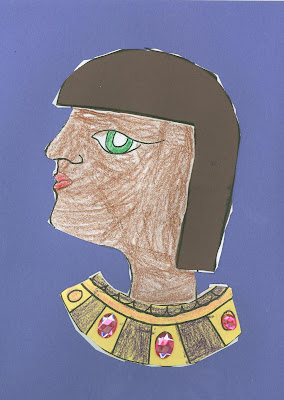
I created templates for the hair, face, and necklace and the students cut out the three shapes. They colored each one in and glued them using glue stick on blue construction paper. If they finished in time they could get 3 gems for their empty spaces.
Monday, January 28, 2008
Classroom Management Tip
This happens everyday, especially with younger students. I'll be explaining directions or reading a story and a hand goes up. I usually keep questions or comments for later, but this student is really smart and may have something special to add so I call on him. "Miss C. do you like my new sneakers?" he asks sweetly. Now I'm off track and so is the rest of the class. Here is a tip how to manage this. Explain to your students what a relevant comment or question would be and tell them when they raise their hands for that to have all five fingers. Explain what an off topic question or comment would be and tell them to only raise their pointer finger for that.
Sunday, January 27, 2008
Friday, January 25, 2008
Post it, Point it Out, Ask a Friend
There are no dumb questions...hmmm I don't know about that. Everyday I have a student ask me a question about a regular procedure that I have done with the students several times before. By answering this student's question I am enabling students to ask questions that they should already know the answers to and it allows them to not be independent thinkers. So what do you do?
1. Post the procedures around the room. Have the same place for items that are continuously used by students so they ought to know where to get them (You could even make signs as to where to find objects in the room).
2. Point it out. You don't even have to speak, just point. "Where do I get a pencil?" Point.
3. When a student was not listening to procedures I tell him/her to ask a friend that was listening. This gets students into the mindset of asking their peers for help and not relying on the teacher as much.
1. Post the procedures around the room. Have the same place for items that are continuously used by students so they ought to know where to get them (You could even make signs as to where to find objects in the room).
2. Point it out. You don't even have to speak, just point. "Where do I get a pencil?" Point.
3. When a student was not listening to procedures I tell him/her to ask a friend that was listening. This gets students into the mindset of asking their peers for help and not relying on the teacher as much.
Wednesday, January 23, 2008
Covering Tables
Whenever I use clay, paper mache, and sometimes paint I always cover the table for easy claenup.
Warning: Clay dust will stick to the tables long after they have been washed and washed and washed!
1. Butcher paper is great, and you can fold it up and reuse it until it's way too gross.
2. Laminate sheets of paper to be used as placemats, or go to the dollar store and get placemats.
3. Rolls of painters plastic or plastic tarps.
4. Cut the seams from large garbage bags and lay them out.
Another tip: Instead of sponges, buy washcloths. You can wash them at home when they get real grungy.
Warning: Clay dust will stick to the tables long after they have been washed and washed and washed!
1. Butcher paper is great, and you can fold it up and reuse it until it's way too gross.
2. Laminate sheets of paper to be used as placemats, or go to the dollar store and get placemats.
3. Rolls of painters plastic or plastic tarps.
4. Cut the seams from large garbage bags and lay them out.
Another tip: Instead of sponges, buy washcloths. You can wash them at home when they get real grungy.
Tuesday, January 22, 2008
Safety Tips
Safety is always a big concern for any teacher, as you are in charge of children. Here are some tips to help in the art room:
1. I have a big problem with students throwing materials to each other. If I catch a student throwing an eraser, he is no longer allowed to use an eraser. I have really had to teach the kids to pass supplies, get out of their seats and get them, or roll them. Another idea is to have several supply boxes around the table for easy reaching.
2. I have a big talk in the beginning of the year where I tell the kids about the paper cutter. I explain to them the dangers of it and show them that it is locked and chained (I went and bought the chain and lock last year with my own money).
3. I do not allow students in the kiln room (without me there)or near the kiln(never ever!). I show them the light that means that it is on and tell them about the dangers.
4. I practice fire drills with kids the first three weeks of school and routinely go over the procedures.
1. I have a big problem with students throwing materials to each other. If I catch a student throwing an eraser, he is no longer allowed to use an eraser. I have really had to teach the kids to pass supplies, get out of their seats and get them, or roll them. Another idea is to have several supply boxes around the table for easy reaching.
2. I have a big talk in the beginning of the year where I tell the kids about the paper cutter. I explain to them the dangers of it and show them that it is locked and chained (I went and bought the chain and lock last year with my own money).
3. I do not allow students in the kiln room (without me there)or near the kiln(never ever!). I show them the light that means that it is on and tell them about the dangers.
4. I practice fire drills with kids the first three weeks of school and routinely go over the procedures.
Labels:
art room,
behavior management,
children,
classroom management,
materials,
procedures,
safety
Monday, January 21, 2008
Some More Financial Advice
Save receipts! If I go to Michaels, JoAnn Fabrics, or Dick Blick I make sure I remember to save my receipts for tax write offs. Last year I moved twice for my job, once to Las Vegas and once across town so I would be closer. I kept my receipts from UHaul and the movers. Any workshops you take, any art supplies you buy for yourself, and college courses you take are all tax write offs. The more you claim the more you get back, so keep a manilla envelope during the year and shove receipts into it for anything that can be construed as a buisness expense. You will thank me in the spring!
Friday, January 18, 2008
Feedback Friday
Being that this is a new blog, and I am completely new to this I thought it would be helpful if I received some feedback every now and then. What do you find most helpful from this blog? What would you like to see more of? Email your answers to LCSC1980@aol.com Thanks!
Wild Hair Self Portrait
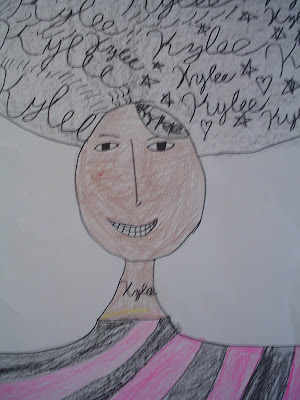
The itinerant art teacher at my school, Melissa Kehr, shared with me this lesson and it was a lot of fun! Students drew linear self-portraits in pencil. When they got to their hair they would draw a circular bubble shape that runs off the page and fill it with their name written in stylized letters. As far as the handwriting fonts were concerned I let the students come up with their own. They traced the whole picture with Sharpie markers and colored their hair, eyes, lips, and clothing with crayon.
Thursday, January 17, 2008
Mccarran Airport Contest
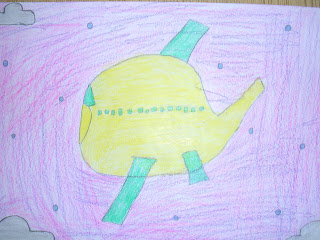

My students are lucky enough to be participants in the McCarran Airport Art Contest. McCarran Airport is building Terminal 3 and asking world renowned artist Robert Silvers to create 10 photomosaics using 30,000 student works of art from Clark County School District. They asked that each artwork be 9"x12" or 11"x8.5;" brightly colored; and depicting a plane, train, or automobile. The 10 best drawings will be chosen as the large images of the photomosaics. This was a great assignment for copming back to school after the winter break. It's not messy, simple in terms of supplies, and I'm using the same supplies for each class.
Wednesday, January 16, 2008
Amazing Projects With Plastic Bags
I have recently become aware of Craftzine which is a magazine dedicated to new ideas in crafts. You should definantly check out his site and even subscribe to the magazine. Here is a link to craft projects made out of plastic shopping bags. Some of these could be used in the classroom and are quite inexpensive! They introduce students to the idea of found object art, recycling, and fashion design. It's really amazing what you can do with a plastic bag.http://craftzine.com/projects/
Labels:
art,
art club,
art education,
art program,
crafts,
fine art,
lesson plan,
materials,
Pop Art,
projects,
recycled materials
Tuesday, January 15, 2008
Clay Fish Sculpture Lesson Plan

Instructional Methods in D.B.A.E
Production
Production
K-12 Visual Arts
Clay Fish Sculpture Lesson Plan
Multicultural / Asian Science
Adaptable to all grades
by
Mignon Slentz
Title: Clay Fish (Koi) Sculpture Grades: Adaptable to all but written for grades 3-5
Sessions: 4 sessions (50 minutes per session)
Sessions: 4 sessions (50 minutes per session)
Academic Integrations: social studies and science
Goal: Students will use clay to make a three-dimensional art form
Objectives:
Students will: learn the Asian cultural background of the Koi fish, learn how to identify and correctly draw a fish, use clay to make a fish sculpture, create textures and patterns in clay, demonstrate craftsmanship, explore ceramic decorating techniques.
National Standards for the visual Arts: grades 3-5
Art Criticism- 1.1 describe works of art. 1.2 analyze, identify & discuss art elements. 1.5 share or evaluate own artwork.
Art History- 2.1 can associate works of art with cultures or time periods. 2.2 understand the influences of art.
Aesthetics- 3.1 art issues: the purpose of art, engage in aesthetic inquiry by discussing responses to art.
Art Production- 4.1 elements of art. 4.2 principles of design. 4.6 create a three-dimensional art form. 4.7 create a pottery form. 4.12 create a work of art that shows the influence of a particular culture.
Vocabulary- Nishikigoi (Koi), Carp, China & Japan (locate on world map), “swimming flowers”, “living jewels”, barbels, gills, dorsal, fin, sculpture, texture, slab roller, slab construction.
Materials- fish visuals, paper, 6’x9’ pattern paper, pencils, scissors, canvas mats, slabs of clay, plastic knives, clay tools, rolling pins, textures, bowls/plastic bags, ceramic glazes, brushes.
Media- show two Power points.
Procedures:Culture/ History: Session one - Introduction and motivation…..1. PowerPoint and discussion of Asian art depicting Koi.Nishikigoi, commonly referred to as “Koi” are the national fish of Japan. “Nishiki” means colored cloth and “Goior Koi” is the Japanese name for carp. Iran is thought to be the ancestral home of the Common Carp, from which Koi were first developed. This wild carp, which is an excellent food source, was carried to China, Japan and Western Europe by traders about a thousand years ago. A first account of them being kept by an emperor in Japan apparently dates back to AD 200. There are actually many theories and dates relating to the original introduction of the Koi. The wild carp has long been a symbol to Asian and Far Eastern countries and has been evident in their paintings, utensils, pottery sculptures and carvings. For hundreds of years, farmers in Japan have been raising Koi for extra food in the ponds they used to flood their rice paddies. About 200 years ago one of the farmers noticed a carp with some red color. Some of the farmers started separating the fish that had different coloration, and breeding them together. Some were kept as pets and in 1914 some of the most beautiful varieties were shown at an exposition in Tokyo and presented to the Crown Prince Hirohito. With the development of air travel, Koi started to migrate to other countries and were introduced to California in the mid 1960s where they became popular residents of fish enthusiast’s back yard ponds.
2. Students will look at pictures of a Koi or other fish and be able to identify the different features.
3. Students will practice drawing fish, adding gills, fins, tails, eyes etc. If time, textures can be drawn in (scales, patterns, designs, etc.). These can be saved for a later lesson.
4. Students will draw a fish filling a 6”x9” scratch paper making sure there are no narrow parts. Cut out. This will be used as a template / pattern.
Production:Session Two:
Preparation- Have enough clay slabs rolled out for each student. Canvas mats, clay tools, water and textures should be on the tables.
Students will watch PowerPoint on clay fish slab construction and discuss if there are questions.
1. Students will each have their paper fish pattern and be given a slab of clay.
Preparation- Have enough clay slabs rolled out for each student. Canvas mats, clay tools, water and textures should be on the tables.
Students will watch PowerPoint on clay fish slab construction and discuss if there are questions.
1. Students will each have their paper fish pattern and be given a slab of clay.
2. Students will place their pattern on the fish and trace around the paper cutting into the clay. Remove scraps from around fish and save for adding features.
3. Using water, smooth cut edges of the fish with your finger. Press or roll on several (at least 2) textures into the clay (plastic texture
sheets, lace, nylon string bags etc.).
sheets, lace, nylon string bags etc.).
4. Using scraps of clay, make an eye and attach by pressing edges with a tool (texture with the end of a screw). Cut or roll a strip of clay to form gill line behind the eye and attach with a tool. Cut a triangular shape for the side fin and attach with a tool. Lines or patterns can be added. Add a mouth.
5. Write name and teacher on the back with a tool.
6. Place flat in a box or set into a bowl for a curved shape or drape upside down over a wadded up plastic bag and let dry.
Session Three:
Preparation: bisque- fire clay fish. Prepare glazes.
1. Students will glaze their clay fish (or watercolor).
Preparation: bisque- fire clay fish. Prepare glazes.
1. Students will glaze their clay fish (or watercolor).
Critique:
Session Four:
Preparation: glaze-fire clay fish and return to students
Session Four:
Preparation: glaze-fire clay fish and return to students
Students will self-evaluate their fish sculptures using the following questions.
A score of 9 and above = E A score of 8 and below = S
CLAY FISH RUBRIC
A score of 9 and above = E A score of 8 and below = S
CLAY FISH RUBRIC
1. Is your fish approximately 5” x 8”?
2. Does your fish have a dorsal (top) fin?
3. Does your fish have a bottom fin?
4. Did you add a side fin?
5. Is there an eye?
6. Are the sides of the fish smooth?
7. Did all your parts stay attached after the 1st firing?
8. Are there at least 2 different textures?
9. Did you add any other decorations/patterns?
10. Did you apply several coats of glaze?
11. Did you use at least 3 colors?
12. Did you show good craftsmanship /neatness?
13. Did YOU write your name and teacher’s initial on
the back?
10. Did you apply several coats of glaze?
11. Did you use at least 3 colors?
12. Did you show good craftsmanship /neatness?
13. Did YOU write your name and teacher’s initial on
the back?
Resources: Clay fish sculpture*http://www.princetonal.com/groups/iad/lessond/middle/Lessons/7th-cerfish.htmKoi*http://swimmingjewels.com/koi_history.html*http://www.koiscapes.com/cat361.html*http://www.netpets.com/fish/reference/freshref/nishi.html
Labels:
art,
art education,
art program,
ceramics,
clay,
cultures,
curriculum,
education,
elementary school,
instruction,
lesson plan,
multicultural,
pottery,
teacher,
teaching,
unit plan
Subscribe to:
Posts (Atom)











